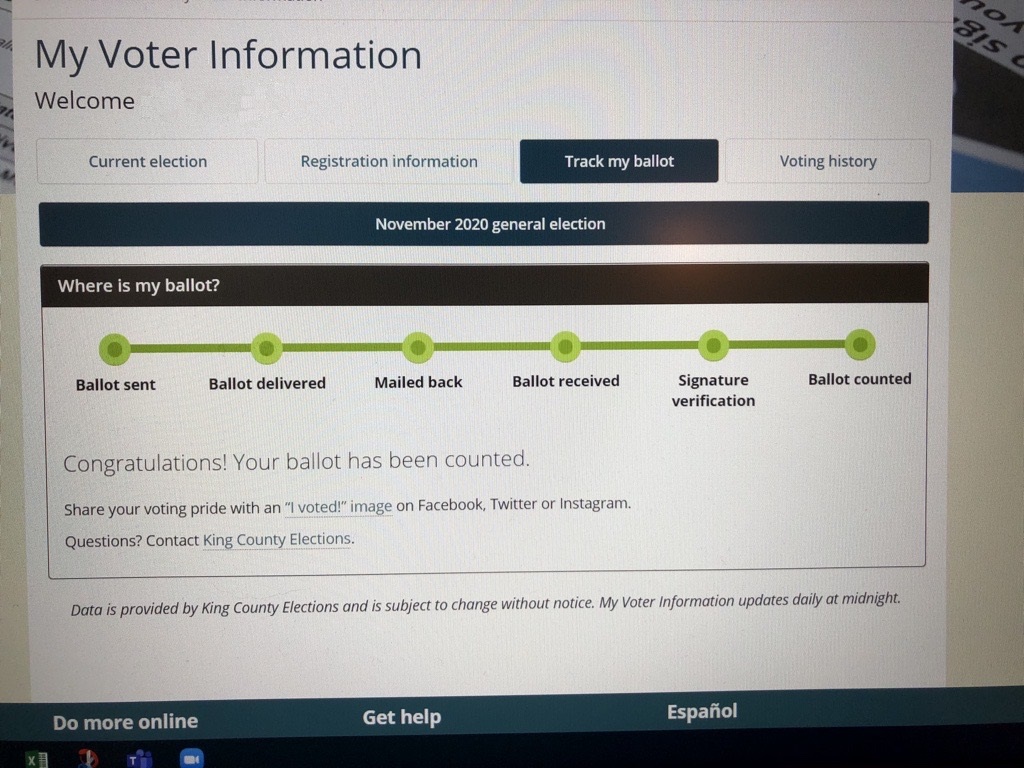This year, as the US grapples with the complications of holding elections during a pandemic and as voters sort through myriad—sometimes contradictory—signals about how, where, and when to vote, Washington and Oregon stand out as shining vote-by-mail oases. Oregonians and Washingtonians know exactly how to vote in 2020; they’ve been voting entirely by mail for a long time. Elections are safe, secure, and smooth in these states. But Oregon and Washington could still up their game. State-wide ballot tracking systems would leave even fewer voters out.
State-wide ballot tracking systems ensure that every voter, no matter which county they live in, has the option to follow the path of their ballot all the way to being counted—and correct anything that snags its progress. A handful of states are out ahead of Washington and Oregon on this score.
Colorado earlier this month became the fifth state to offer statewide comprehensive tracking through BallotTrax, an individual ballot tracking tool, implementing one of Sightline’s key recommendations for safe and secure mail-in voting.
Only four other states provide ballot tracking statewide, according to the National Vote at Home Institute: California, Nevada, Virginia and North Carolina. In another 12 states (Arizona, Arkansas, Florida, Illinois, Kansas, Michigan, Ohio, Oregon, South Carolina, Tennessee, Texas, Washington), the state offers a portal with more limited information, and some counties offer comprehensive tracking.
While Oregon and Washington have (rightly) been held up as national examples for secure mail-in voting, the two veteran vote-by-mail states fall short when it comes to providing all voters statewide with comprehensive ballot tracking—that is, the ability to get a text message or other notification when your ballot is mailed, when it arrives in your mailbox, when it’s received at the elections office, and when it’s counted. Many voters in Washington and Oregon can sign up to get a text message alerting them to every step in their ballot’s progress, from the moment their blank ballot is mailed, to the moment their returned ballot is accepted. But others can only see whether it was mailed, received or processed after logging in to a state website. It depends on what county they live in, and rural voters and voters in poorer counties tend to get the short end of the stick as their local officials have fewer resources to invest in tracking.
Larger counties in Washington and Oregon—Multnomah County in Oregon, which includes Portland, and King County in Washington, which includes Seattle—pay to provide this service for their voters, but smaller counties with smaller budgets don’t.
Why ballot tracking matters
How does it work? Comprehensive ballot tracking uses USPS-intelligent barcodes to give voters step-by-step updates on where their ballot is in the process. Voters can opt to receive these updates by text, phone message, or email. In Colorado, registered voters are automatically enrolled, but they can choose to opt out any time. Most states have state portals that offer more limited ballot tracking. The more limited state portals use data from election officials, not from USPS intelligent barcodes, and don’t give voters notifications, but voters can log in to the online portal to see whether their ballot has been mailed, received, or counted. Only four states (Connecticut, Mississippi, Missouri, and Wyoming) offer no ballot tracking.
Tracking ballots can become an important tool to reduce the number of disenfranchised voters.

Tracking ballots can become an important tool to reduce the number of disenfranchised voters. In some states, voters aren’t informed if their ballot has an issue and won’t be counted; that means they aren’t given the chance to cure their signatures. With comprehensive ballot tracking, the voter would be notified right away if there was a problem with their ballot, find out what was missing or under scrutiny, and be given more time to fix any errors and, ultimately, make sure their vote was successfully cast.
Boulder County Clerk and Recorder Molly Fitzpatrick has said the state’s new ballot tracking service “provides a measure of reassurance to voters” that their ballots will be counted. Voters can breathe a sigh of relief knowing their ballots are where they’re supposed to be, at a time when the validity of mail-in ballots is constantly being questioned. “It’s the most popular tool we offer voters,” said Tim Scott, the director of elections for Multnomah County, Oregon.
With only a state portal, some voters are left wondering whether their mail-in ballot would make it to their home in time for them to make crucial state deadlines. In some states, voters are still waiting for their absentee ballots they requested weeks ago. In New York, some voters even got ballots mailed to them with errors, such as the wrong names and addresses, giving voters another obstacle to overcome before they could focus on ensuring they get timely postmarks. With ballot tracking, voters could even see where their ballots are in the process and sometimes even discover red flags before they arrive, helping to ensure their votes can be conveniently cast and counted.
Without a statewide implementation of ballot tracking, cities and counties in Oregon and Washington—and states across the US—will continue to take the initiative to provide comprehensive ballot tracking to voters in their local jurisdiction. But that means the service depends on where the voter lives. Portland voters, for example, have a way to track their ballot, while voters in other parts of the state are out of luck. Many of those rural counties may have limited budgets and are less inclined to spend the money on an additional service—leaving more rural voters with less certainty and more risk of disenfranchisement.

